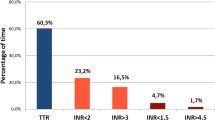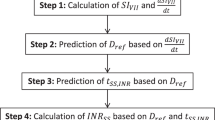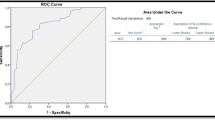Abstract
The International Normalized Ratio (INR) monitoring is an essential component to manage thrombotic disease therapy. This study presents a semi-empirical model of INR as a function of time and assigned therapy (Warfarin, k-vitamin). With respect to other methodologies, this model is able to describe the INR using a limited number of parameters and is able to describe the time variation of INR described in the literature. The presented methodology showed great accuracy in model calibration [(trueness (precision)]: 0.2% (0.1%) to 1.2% (0.3%) for coagulation factors, from 5% (9%) to 9.7% (12%) for Warfarin-related parameters and 38% (40%) for K-vitamin-related parameters. The latter value was considered acceptable given the assumptions made in the model. It has two other important results: the first is that it was able to correctly estimate INR with respect to daily therapy doses taken from the literature. The second is that it introduces a single numeric semi-empirical parameter that is able to correlate INR/dose response to physiological and environmental condition of patients.
Graphic abstract












Similar content being viewed by others
References
Ageno W, Gallus AS, Wittkowsky A, Crowther M, Hylek EM, Palareti G (2012) Oral anticoagulant therapy: Antithrombotic Therapy and Prevention of Thrombosis, 9th ed: American College of Chest Physicians Evidence-Based Clinical Practice Guidelines. Chest 141(2 Suppl):e44S-e88S. https://doi.org/10.1378/chest.11-2292
Al-Rashid M, Parker MJ (2005) Anticoagulation management in hip fracture patients on warfarin. Injury 36(11):1311–1315. https://doi.org/10.1016/j.injury.2005.05.004
Baglin TP, Keeling DM, Watson HG (2006) Committee British, for Standards in Haematology, Guidelines on oral anticoagulation (warfarin): third edition-2005 update. Br J Haematol 132(3):277–85. https://doi.org/10.1111/j.1365-2141.2005.05856.x
Barcellona D, Fenu L, Marongiu F (2017) Point-of-care testing INR: an overview. Clin Chem Lab Med 55(6):800–805. https://doi.org/10.1515/cclm-2016-0381
Bauer KA, Nguyen-Cao TM, Spears JB (2016) Issues in the Diagnosis and Management of Hereditary Antithrombin Deficiency. Ann Pharmacother 50(9):758–67. https://doi.org/10.1177/1060028016651276
Bhatia M, Talawadekar G, Parihar S, Smith A (2010) An audit of the role of vitamin K in the reversal of International Normalised Ratio (INR) in patients undergoing surgery for hip fracture. Ann R Coll Surg Engl 92(6):473–6. https://doi.org/10.1308/003588410X12664192075774
Burghaus R, Coboeken K, Gaub T, Niederalt C, Sensse A, Siegmund HU, Weiss W, Mueck W, Tanigawa T, Lippert J (2014) Computational investigation of potential dosing schedules for a switch of medication from warfarin to rivaroxaban-an oral, direct Factor Xa inhibitor. Front Physiol 5(OCT):417, https://doi.org/10.3389/fphys.2014.00417
Chinnaraj M, Planer W, Pozzi N (2018) Structure of Coagulation Factor II: Molecular Mechanism of Thrombin Generation and Development of Next-Generation Anticoagulants. Front Med 5:281. https://doi.org/10.3389/fmed.2018.00281
Choonara I, Haynes B, Cholerton S, Breckenridge A, Park B (1986) Enantiomers of warfarin and vitamin K1 metabolism. Br J Clin Pharmacol 22(6):729–732. https://doi.org/10.1111/j.1365-2125.1986.tb02966.x
Clarke R, Ross S, Walker T, Woods D (2006) INR Testing. Tech. rep., bpac (nz), Dunedin (NZ)
Cohn MR, Levack AE, Trivedi NN, Villa JC, Wellman DS, Lyden JP, Lorich DG, Lane JM (2017) The Hip Fracture Patient on Warfarin: Evaluating Blood Loss and Time to Surgery. J Orthop Trauma 31(8):407–413. https://doi.org/10.1097/BOT.0000000000000857
Dager WE (2012) Warfarin for venous thromboembolism prophylaxis after elective hip or knee arthroplasty: exploring the evidence, guidelines, and challenges remaining. Ann Pharmacother 46(1):79–88. https://doi.org/10.1345/aph.1P626
van Dijk KN, Plat AW, van Dijk AAC, Piersma-Wichers M, de Vries-Bots AMB, Slomp J, de Jong-van den Berg LTW, Brouwers JRBJ, (2004) Potential interaction between acenocoumarol and diclofenac, naproxen and ibuprofen and role of CYP2C9 genotype. Thromb Haemost 91(1):95–101. https://doi.org/10.1160/TH03-05-0325
Douketis JD (2016) The 2016 American College of Chest Physicians treatment guidelines for venous thromboembolism: a review and critical appraisal. Intern Emerg Med 11(8):1031–1035. https://doi.org/10.1007/s11739-016-1553-0
Eriksson N, Wadelius M (2012) Prediction of warfarin dose: why, when and how? Pharmacogenomics 13(4):429–40. https://doi.org/10.2217/pgs.11.184
Fennerty A, Dolben J, Thomas P, Backhouse G, Bentley DP, Campbell IA, Routledge PA (1984) Flexible induction dose regimen for warfarin and prediction of maintenance dose. Br Med J (Clin Res Ed) 288(6426):1268–70
Fogelson AL, Neeves KB (2015) Fluid Mechanics of Blood Clot Formation. Annu Rev Fluid Mech 47:377–403. https://doi.org/10.1146/annurev-fluid-010814-014513
Francis B, Lane S, Pirmohamed M, Jorgensen A (2014) A review of a priori regression models for warfarin maintenance dose prediction. PLoS One 9(12):e114896. https://doi.org/10.1371/journal.pone.0114896
Franco V, Polanczyk CA, Clausell N, Rohde LE (2004) Role of dietary vitamin K intake in chronic oral anticoagulation: prospective evidence from observational and randomized protocols. Am J Med 116(10):651–6. https://doi.org/10.1016/j.amjmed.2003.12.036
Gage BF, Fihn SD, White RH (2000) Management and dosing of warfarin therapy. Am J Med 109(6):481–8
Gage BF, Eby C, Johnson JA, Deych E, Rieder MJ, Ridker PM, Milligan PE, Grice G, Lenzini P, Rettie AE, Aquilante CL, Grosso L, Marsh S, Langaee T, Farnett LE, Voora D, Veenstra DL, Glynn RJ, Barrett A, McLeod HL (2008) Use of pharmacogenetic and clinical factors to predict the therapeutic dose of warfarin. Clin Pharmacol Ther 84(3):326–31. https://doi.org/10.1038/clpt.2008.10
Gage BF, Bass AR, Lin H, Woller SC, Stevens SM, Al-Hammadi N, Li J, Rodríguez T, Miller JP, McMillin GA, Pendleton RC, Jaffer AK, King CR, Whipple BDV, Porche-Sorbet R, Napoli L, Merritt K, Thompson AM, Hyun G, Anderson JL, Hollomon W, Barrack RL, Nunley RM, Moskowitz G, Dávila-Román V, Eby CS (2017) Effect of genotype-guided warfarin dosing on clinical events and anticoagulation control among patients undergoing hip or knee arthroplasty: The GIFT randomized clinical trial. JAMA - J Am Med Assoc 318(12):1115–1124. https://doi.org/10.1001/jama.2017.11469
Gleason LJ, Mendelson DA, Kates SL, Friedman SM (2014) Anticoagulation management in individuals with hip fracture. J Am Geriatr Soc 62(1):159–164. https://doi.org/10.1111/jgs.12591
Hamberg AK, Dahl ML, Barban M, Scordo MG, Wadelius M, Pengo V, Padrini R, Jonsson EN (2007) A PK-PD model for predicting the impact of age, CYP2C9, and VKORC1 genotype on individualization of warfarin therapy. Clin Pharmacol Ther 81(4):529–38. https://doi.org/10.1038/sj.clpt.6100084
Hart BM, Ferrell SM, Motejunas MW, Bonneval LA, Cornett EM, Urman RD, Kaye AD (2018) New anticoagulants, reversal agents, and clinical considerations for perioperative practice. Best Pract Res Clin Anaesthesiol 32(2):165–178. https://doi.org/10.1016/j.bpa.2018.06.008
Hirsh J, Fuster V, Ansell J, Halperin JL (2003) Association American Heart, College American, of Cardiology Foundation, American Heart Association/American College of Cardiology Foundation guide to warfarin therapy. Circulation 107(12):1692–711. https://doi.org/10.1161/01.CIR.0000063575.17904.4E
Hisada Y, Mackman N (2017) Cancer-associated pathways and biomarkers of venous thrombosis. Blood 130(13):1499–1506. https://doi.org/10.1182/blood-2017-03-743211
ISO 5725 (1994) Accuracy (trueness and precision) of measurement methods and results
ISO 5725-3 (1994) Intermediate measures of the precision of a standard measurement method
Kamwal RP (1998) Generalized Functions: theory and technique, 2nd edn. Birkhäuser, Boston
Kaushansky K, Lichtman MA, Prchal JT, Levi MM, Press OW, Burns LJ, Caligiuri MA (2016) Williams hematology, 9th edn. McGraw-Hill Education
Klein TE, Altman RB, Eriksson N, Gage BF, Kimmel SE, Lee MTM, Limdi NA, Page D, Roden DM, Wagner MJ, Caldwell MD, Johnson JA, International Warfarin Pharmacogenetics Consortium, Klein TE, Altman RB, Eriksson N, Gage BF, Kimmel SE, Lee MTM, Limdi NA, Page D, Roden DM, Wagner MJ, Caldwell MD, Johnson JA (2009) Estimation of the warfarin dose with clinical and pharmacogenetic data. N Engl J Med 360(8):753–764. https://doi.org/10.1056/NEJMoa0809329
Kuruvilla M, Gurk-Turner C (2001) A review of warfarin dosing and monitoring. Proc (Bayl Univ Med Cent) 14(3):305–6
Lane DA, Lip GYH (2007) Maintaining therapeutic anticoagulation: the importance of keeping “within range.” Chest 131(5):1277–9. https://doi.org/10.1378/chest.07-0273
Lee C, Coleman RW, Mungall DR (1987) Effect of using warfarin plasma concentrations in Bayesian forecasting of prothrombin-time response. Clin Pharm 6(5):406–12
Luo Z, Li X, Zhu M, Tang J, Li Z, Zhou X, Song G, Liu Z, Zhou H, Zhang W (2017) Identification of novel variants associated with warfarin stable dosage by use of a two-stage extreme phenotype strategy. J Thromb Haemost 15(1):28–37. https://doi.org/10.1111/jth.13542
Magee L (1990) R2 Measures Based on Wald and Likelihood Ratio Joint Significance Tests. Am Stat 44(3):250–253
Mahtani KR, Heneghan CJ, Nunan D, Bankhead C, Keeling D, Ward AM, Harrison SE, Roberts NW, Hobbs FDR, Perera R (2012) Optimal loading dose of warfarin for the initiation of oral anticoagulation. Cochrane database Syst Rev 12:CD008685, https://doi.org/10.1002/14651858.CD008685.pub2
Mangoni AA, Jackson SHD (2004) Age-related changes in pharmacokinetics and pharmacodynamics: basic principles and practical applications. Br J Clin Pharmacol 57(1):6–14. https://doi.org/10.1046/j.1365-2125.2003.02007.x
Narayanan MN, Lucas SB (1993) A genetic algorithm to improve a neural network to predict a patient’s response to warfarin. Methods Inf Med 32(1):55–8
Nutescu EA, Bautista A, Gao W, Galanter WL, Schumock GT, Mody SH, Bookhart BK, Lambert BL (2013) Warfarin anticoagulation after total hip or total knee replacement: Clinical and resource-utilization outcomes in a university-based antithrombosis clinic. Am J Heal Pharm 70(5):423–430. https://doi.org/10.2146/ajhp120341
Olivieri M, Bidlingmaier C, Schetzeck S, Borggräfe I, Geisen C, Kurnik K (2012) Arterial thrombosis in homozygous antithrombin deficiency. Hamostaseologie 32(SUPPL. 1):S79-82. https://doi.org/12410S79 [pii]
Opartkiattikul N (1999) Standardization of coagulation tests. Southeast Asian J Trop Med Public Health 30(Suppl 3):79–85
Ovesen L, Lyduch S, Ott P (1989) A simple technique for predicting maintenance dosage of warfarin-is it better than empirical dosing? Eur J Clin Pharmacol 37(6):573–6
Palta S, Saroa R, Palta A (2014) Overview of the coagulation system. Indian J Anaesth 58(5):515–23. https://doi.org/10.4103/0019-5049.144643
Poller L, Wright D, Rowlands M (1993) Prospective comparative study of computer programs used for management of warfarin. J Clin Pathol 46(4):299–303
Schafer AI, Levine MN, Konkle BA, Kearon C (2003) Thrombotic disorders: diagnosis and treatment. Hematol Am Soc Hematol Educ Progr pp 520–39
Schulman S, Lockner D, Bergström K, Blombäck M (1984) Intensive initial oral anticoagulation and shorter heparin treatment in deep vein thrombosis. Thromb Haemost 52(3):276–80
Schulman S, Hwang HG, Eikelboom JW, Kearon C, Pai M, Delaney J (2014) Loading dose vs. maintenance dose of warfarin for reinitiation after invasive procedures: A randomized trial. J Thromb Haemost 12(8):1254–1259, https://doi.org/10.1111/jth.12613
Schurgers LJ, Shearer MJ, Hamulyák K, Stöcklin E, Vermeer C (2004) Effect of vitamin K intake on the stability of oral anticoagulant treatment: dose-response relationships in healthy subjects. Blood 104(9):2682–9. https://doi.org/10.1182/blood-2004-04-1525
Sconce E, Avery P, Wynne H, Kamali F (2007) Vitamin K supplementation can improve stability of anticoagulation for patients with unexplained variability in response to warfarin. Blood 109(6):2419–23. https://doi.org/10.1182/blood-2006-09-049262
Self TH, Oliphant CS, Reaves AB, Richardson AM, Sands CW (2015) Fever as a risk factor for increased response to vitamin K antagonists: a review of the evidence and potential mechanisms. Thromb Res 135(1):5–8. https://doi.org/10.1016/j.thromres.2014.10.015
Sheiner LB (1969) Computer-aided long-term anticoagulation therapy. Comput Biomed Res 2(6):507–18
Svec JM, Coleman RW, Mungall DR, Ludden TM (1985) Bayesian pharmacokinetic/pharmacodynamic forecasting of prothrombin response to warfarin therapy: preliminary evaluation. Ther Drug Monit 7(2):174–80
Tie JK, Stafford DW (2016) Structural and functional insights into enzymes of the vitamin K cycle. J Thromb Haemost 14(2):236–247. https://doi.org/10.1111/jth.13217
Vadher B, Patterson DL, Leaning M (1999) Prediction of the international normalized ratio and maintenance dose during the initiation of warfarin therapy. Br J Clin Pharmacol 48(1):63–70
White RH, McKittrick T, Hutchinson R, Twitchell J (1995) Temporary discontinuation of warfarin therapy: changes in the international normalized ratio. Ann Intern Med 122(1):40–2
Wigle P, Hein B, Bloomfield HE, Tubb M, Doherty M (2013) Updated guidelines on outpatient anticoagulation. Am Fam Physician 87(8):556–66
Williams BA, Evans MA, Honushefsky AM, Berger PB (2017) Clinical Prediction Model for Time in Therapeutic Range While on Warfarin in Newly Diagnosed Atrial Fibrillation. J Am Heart Assoc 6(10), https://doi.org/10.1161/JAHA.117.006669
Yamreudeewong W, Wong HK, Brausch LM, Pulley KR (2009) Probable interaction between warfarin and marijuana smoking. Ann Pharmacother 43(7):1347–53. https://doi.org/10.1345/aph.1M064
Young G, Albisetti M, Bonduel M, Brandao L, Chan A, Friedrichs F, Goldenberg NA, Grabowski E, Heller C, Journeycake J, Kenet G, Krümpel A, Kurnik K, Lubetsky A, Male C, Manco-Johnson M, Mathew P, Monagle P, van Ommen H, Simioni P, Svirin P, Tormene D, Nowak-Göttl U (2008) Impact of inherited thrombophilia on venous thromboembolism in children: a systematic review and meta-analysis of observational studies. Circulation 118(13):1373–82. https://doi.org/10.1161/CIRCULATIONAHA.108.789008
Zwingerman N, Medina-Rivera A, Kassam I, Wilson MD, Morange PE, Trégouët DA, Gagnon F (2017) Sex-specific effect of CPB2 Ala147Thr but not Thr325Ile variants on the risk of venous thrombosis: A comprehensive meta-analysis. PLoS One 12(5):e0177768. https://doi.org/10.1371/journal.pone.0177768
Acknowledgements
I would like to thank Dr. Maria Paola Landini and Dr. Milena Fini for their support and encouragement in the preparation of this work. I would also like to thank Eng. Gregorio Marchiori for valuable feedback on the writing of the manuscript. Lastly, my wife my son for ideas and motivation.
Author information
Authors and Affiliations
Corresponding author
Ethics declarations
Conflict of interest
The author has no financial or personal relationships with anyone that could inappropriately influence the work presented.
Additional information
Publisher's Note
Springer Nature remains neutral with regard to jurisdictional claims in published maps and institutional affiliations.
Rights and permissions
About this article
Cite this article
Bontempi, M. Semi-empirical anticoagulation model (SAM): INR monitoring during Warfarin therapy. J Pharmacokinet Pharmacodyn 49, 271–282 (2022). https://doi.org/10.1007/s10928-021-09783-8
Received:
Accepted:
Published:
Issue Date:
DOI: https://doi.org/10.1007/s10928-021-09783-8




